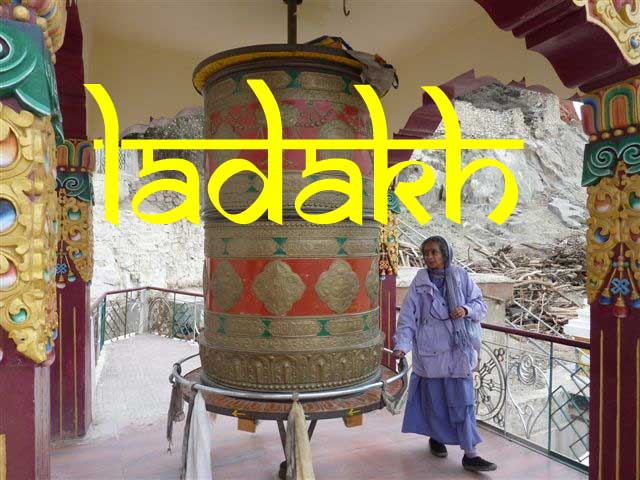 LADAKH
Our trip to Ladakh was a sudden decision and like all Vanamali’s decisions the more sudden they are the more perfectly the whole thing is organized. I was in Malaysia for the book launch and Mohan was in Kerala but I knew that he always had a great hankering to go to Ladakh. Of course I was never that interested in visiting any place which couldn’t boast of any temples but I knew that this was HIS decision so I said that if Mohan could get us on a tour starting on the 6th June, the day of my return, I was happy to go. As expected he found a tour for the 6th which had only 2 seats left so it was all too perfect. I landed in Delhi from KL at 10 pm and had to start from the house at 3 pm to catch the flight at 5 am. Somehow managed it. The scene from the plane was breathtaking. We were flying over the whole of the Karakoram Range at a fairly low level with the rising sun glinting over the whole scene and lighting it up as if on a stage. I had never seen anything like this, not even on our flights to Nepal. Fluted hills and deep vales made the whole scene spectacular. It was only an hour’s drive to Leh, the capital of Ladakh which is at a height of 11,200 ft, about the height of Kedarnath. We landed in the tiny airport to be met with a row of Xylos and other vehicles which were supposed to take us to our hotels. Even though it was a guided tour, there were only about 6 people to each vehicle and we each had our own driver who never changed during the course of the week so that made it more personal. We were taken to the Hotel Ladakh which was in the style of all the hotels in Leh, with ornamented wood carvings over the doors and windows and wooden balconies which made it look quite charming. 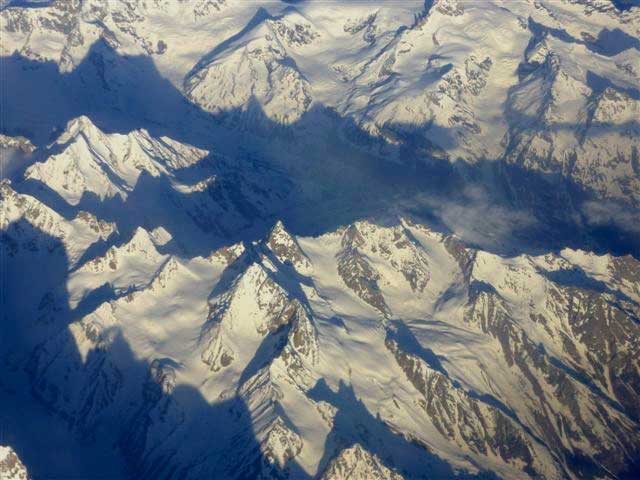 Leh
is the largest province within the North Indian State of Jammu and
Kashmir, covering approximately 60,000 square miles (100,000 sq. km). It
is surrounded and bisected by some of the highest mountain ranges in
the world. Running in a generally northwest to southeast direction
through Ladakh, the great Himalayan Range separates the valley of
Kashmir from Ladakh.
Leh
has no flora and the only trees were the stark poplars which shot up
into the sky with scraggly branches which gave little shade in a country
which didn’t need any shade most of the time. The temperature was about
15 Celsius rising to 25 and even 30 in the sun at noon. We really
didn’t need any of the warm clothes we had brought.
The hotel room was simple and sweet. Since most people are prone to altitude sickness at such heights we had been given strict instructions to take complete rest the whole day. I was most susceptible to altitude sickness so for the first time in my life I had some enforced rest, just lying and doing nothing, not even thinking. I as a bit breathless and had a headache but apart from that I felt OK. We started our actual tour the next morning at 10 am to the Thiksey Monastery which is situated at a distance of approximately 18 km from the town of Leh. It is one of the most beautiful monasteries in Ladakh, and belongs to the Gelukpa Order of Buddhism.The old monastery was reconstructed in 1430 AD. The Gompa (monastery) is perched on a hill top as most of the monasteries are, to the north of the Indus River. 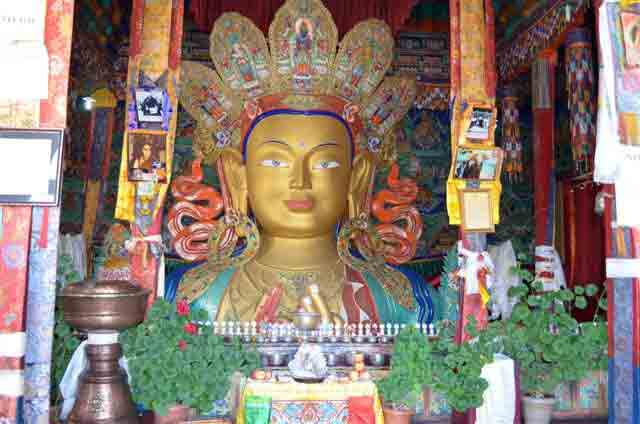 Thiksey Monastery 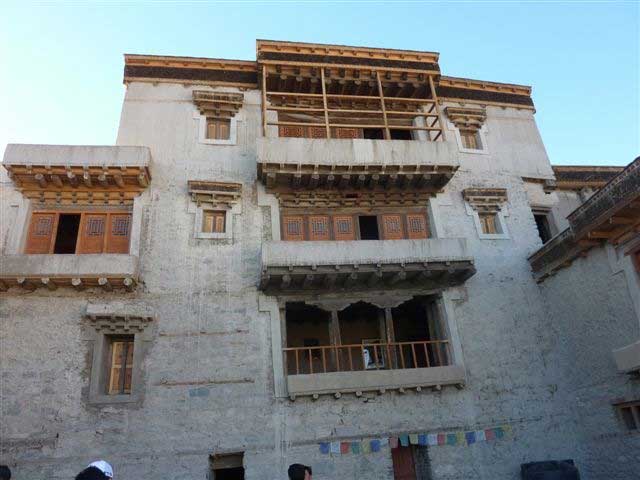 On our way back to Leh, we were taken to the Sindhu Ghat which really has nothing much to boast of except that it is a sparkling river flowing over stones surrounded by the barren brown mountains of Ladakh. Of course I went and dabbled my feet in the holy river and sprinkled some water on the rest of our party. The next day we went to the Leh palace which dominates the town of Leh. It was poor imitation of the famous Potiala palace in Lahsa the seat of the previous Dalai Lamas. The palace was built in the 17th century by King Singe Namgyal as the royal residence. It was deserted in the mid-19th century after the family shifted to Stok. It was built of mud bricks that have kept their colour. The pillars of the huge entrance were built of the trunks of many poplar trees which are the only trees to be found here. It was a most interesting castle and I could just imagine that some of the palaces described in the Mahabharata might have been like this. We went right up to the battlements from which we could have a magnificent view of the town of Leh with the Sindhu passing through like a silver bracelet. 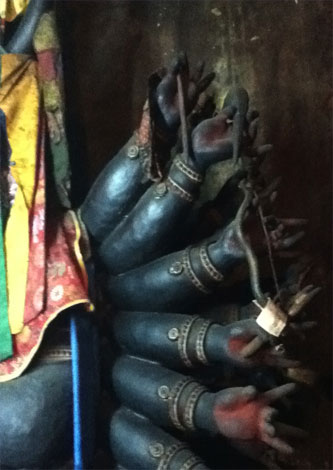 Mahishasuramardini's Arms Next we climbed further up to the Tsemo Gompa attached to the castle in which the monks still live. It was truly beautiful. Without really knowing anything I stumbled into a lovely shrine of Bhadrakali as Mahishasuramardini with eighteen arms all holding different types of weapons. She was a huge figure flanked by a statue of Yama Dharma Raja with the headdress of the horns of a buffalo and other fearsome figures at the other side. The faces of all these idols were covered with cloth. Apparently no one could look at the faces since they were all so terrifying. They were revealed only seven days in a year when the priest did the puja. I stayed a while and meditated. The vibrations were incredible. As I closed my eyes I could feel her already huge figure growing and growing out of all proportions right up to the sky. Yet I felt no fear but only a deep compassion emanating out of her embracing the whole of our sick world, filled with horror and violence. It was as if her very terrifying presence could suck in the terror of the world. I felt a deep sense of peace as I left that place and was grateful to her for showing her face to me. I don’t think that many people ever came to this little room tucked away inside this monastery. Our next stop was at the Shanti Stupa located on a hilltop at Changspa. We could have a wonderful view of the stupa all lighted up in the night from our hotel. At close quarters it was seen to be a most impressive structure and was constructed by a Japanese Buddhist organization, known as 'The Japanese for World Peace'. It was built to commemorate 2500 years of Buddhism and to promote World Peace. His Holiness, the Dalai Lama inaugurated the Shanti Stupa in the year 1985. We had a panoramic view of Leh from the stupa. The next day we set off very early since we were off to the impassable Khardung La pass which was 18,380 ft. Magnificent views of the huge Karakoram Range with glittering snow tops stayed with us the whole time. We were desperate to take photos but then realized that with every hair pin bend we were literally moving closer and closer to these ranges. 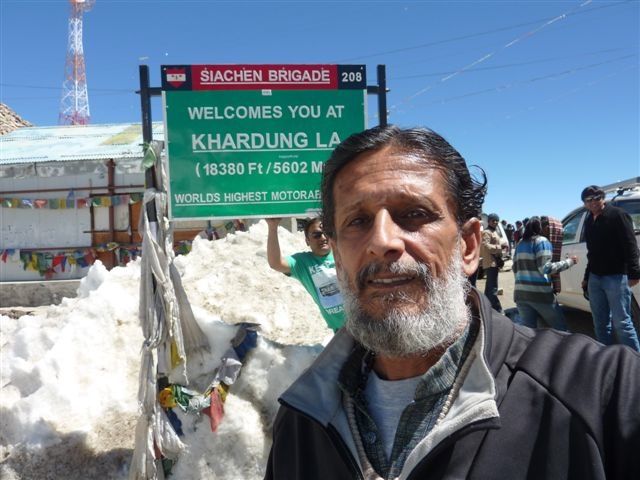 By this time I had had enough and just about managed to scrabble over the mountains of snow and get back to the road and car and jump inside before I started to get really sick. Of course the whole place was strung with Tibetan good luck flags all waving merrily in the breeze. They had even made a small “gompa” or monastery covered with multi colored flags. It was as if their country was so bleak and lacking in color that they tried to make up for it by making houses and designs and flags filled with all sorts of colors. At last everyone had their fill of taking photos and the caravan of Xylos and Scorpios started to move forward. 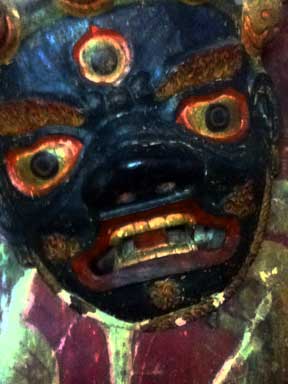 Now we came to another type of scenery. We passed the snow line and found that even though the aspect was still bleak, the monotony was cut by the numerous rivulets gurgling over the stones. The other two couples with us were from the south and had never experienced such scenes so they yanked out their shoes and jumped out and started dabbling their feet in the water only to find that their feet were frozen within seconds. The rest of the landscape was filled with sharp rocks and shale broken with the fabulous snow capped peaks at the background. Our next stop was at the famous Diskit monastery which covered the whole of the hill on one side. They had also built a 70 foot statue of the Maitreya Buddha which dominated the whole landscape for miles around. We climbed up in the hot sun and were rewarded with a fantastic view of the valley and of course the colossal statue which had a most benign expression and was covered with numerous colors as expected. 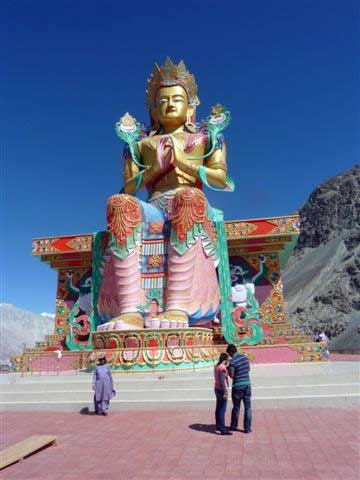 This Gompa has quite an interesting legend attached to it. It is believed that a Mongol demon once lived here and was a sworn enemy of Buddhism. He was killed near the monastery. However, even after his death, his body kept coming back to the monastery again and again. It is said that even today the wrinkled head and hand of the demon lie inside a temple of the monastery, which is filled with fierce Gods and Goddesses. Next we came down to the Hunder valley which must be unique since the whole vale was filled with sand dunes in numerous shapes carved by the wind god , Vayu, which kept changing and forming innumerable shapes. That might have been a common sight in many deserts but the background to these sand dunes was the snow capped Karakoram Range and through the valley ran the Sindhu (Indus) river, dancing and gurgling since she was still only a young and beautiful girl. This is the place where the unusual, double-humped, Bactrian camels are found. They are also called Dromedaries. The river was a delight to see – such clear, sparkling water which could be drunk since it was coming straight from the peaks. Our couples of course insisted on taking a ride on the camels while we relaxed on the side of the river beneath a thorny bush. Our night halt was the famous Nubra valley in which our army had fought a victorious battle with the Chinese who were on the borders of this valley. It is popularly known as the orchard of Ladakh. In summer there is a riotous cascade of yellow and pink wild roses and a carpet of wild lavender in the post monsoon season. This is the only place in Ladakh which has some vegetation even though the sand dunes were there. In fact when we entered the camp site I was delighted to find that even though there had been no rains the pink and yellow wild roses were scattered all over the compound. Gushing rivulets danced all round the tents and there was the sound of birds chirping which is again quite a novel sound since I never heard any birds in Leh. 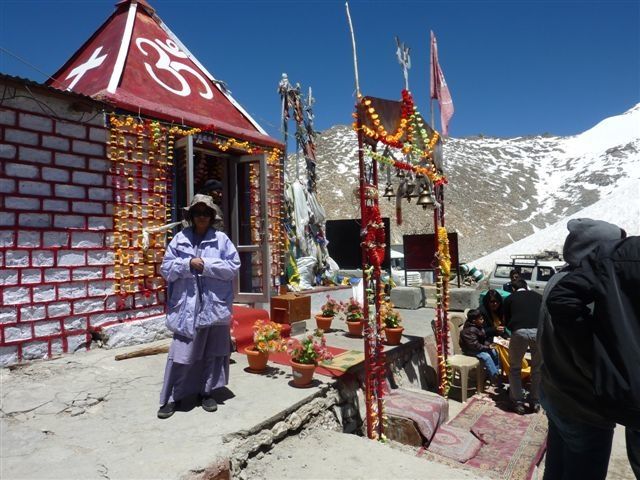 The return journey was pretty much the same except that we could see new parts of the range and had the ever gurgling Sindhu beside us. There was a lovely waterfall which appeared to be coming out of sheer rock about 100 feet above in a fairly thick trickle and gathering momentum and volume until it crashed with a mighty roar on the side of the road. We passed Kardunga which was the place where we had lunch the previous day and then on to the Khandung La pass which did not seem as cold. The snow was melting since the last two days had been exceptionally hot. There were many bikers all set to get name and fame at having dared to venture on the highest motorable road in the world! What was more surprising was that we passed quite a few hardy cyclists on mountain bikes struggling up and down the mountain side. I must admit that most of them were Europeans and included quite a few ladies. The motor cyclists were mostly Indians. Returning to the hotel seemed quite a mundane thing after all the exciting events of the previous two days but the body demanded some rest so a hot bath and bed was extremely welcome. The next day we set out on a new route which was the road to Kargil which is the second biggest town of Ladakh. Our first stop was at the “Hall of Fame”, in which all the details of all the wars the Indian army has fought against Chinese and Pakistani forces in this area were given. You will find memorabilia, biographies of eminent defense personalities, images and weapons used during the Kargil war as well as belongings of enemy soldiers found at the war sites. Another section is entirely dedicated to Siachen and its heroes. In one of the rooms we can see the type of clothing worn by the soldiers during heavy snowfall, and the weapons used by them. One feels like crying when we see their daily rations which was composed of mainly frozen and packed foods, which is heated by lighting small balls of Hexamycin tablets, as fire is difficult to ignite at a temperature dipping -30 deg to -50 deg centigrade. 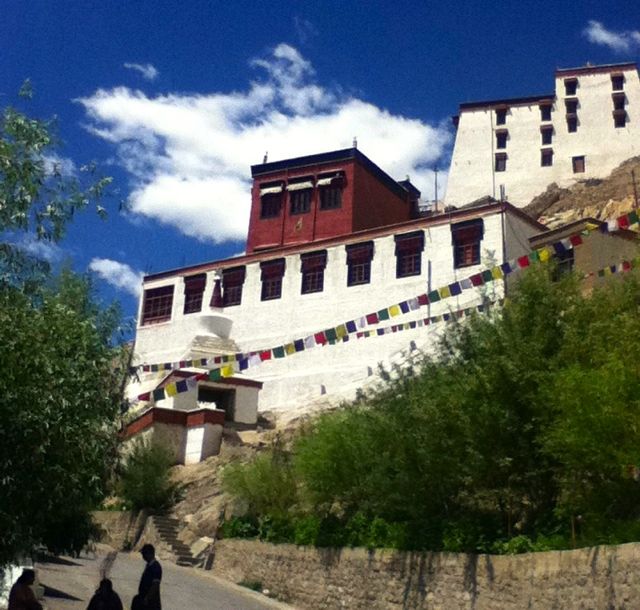 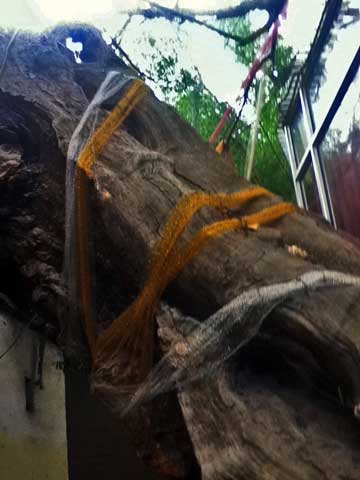 Ancient tree planted by Gugu Nanak in the 14th century The next port of call was to the Gurudwara known as “Pathar Sahib”. This was a sacred place in which the first Guru of the Sikhs – Guru Nanak meditated. This is a beautiful Gurudwara about 25 miles away from Leh, on the Kargil road, 12000 ft above sea level. The Gurudwara was built in 1517 to commemorate the visit to the Ladakh region of Guru Nanak Dev, the founder Guru of the Sikh faith. The story goes that when Nanakji was meditating an asura saw him and wanted to destroy him and threw a huge rock at him. It hit him on his shoulder but apparently the rock became soft as butter and his shoulder just carved a space into the rock and he remained undisturbed in his meditation. The asura came down expecting to see his enemy flattened out by the stone and was surprised to see him sitting serenely, totally unaware of the happenings around him. The furious asura aimed a mighty kick at the stone which again gave way so that the imprint of his feet remained there forever. It was then that the asura realised that this must indeed be a very holy man and he surrendered at his feet and became his disciple. This stone is kept in this Gurudwara and we can still see the dents made by Guru Nanakji’s shoulder and the feet of the asura. The stone steps leading to the shrine at the top were burning hot but somehow we managed it and sat for some time drinking in the peace and quiet of the place. Since it was lunch time, they insisted that we stay for the “langar” which is the sanctified food which is served absolutely free to all those who come there at that time. This is an amazing fact of the Sikh Gurudwaras that they serve free food to all. Nobody is turned away. This is done even in those Gurudwaras which are in inaccessible spots like this one and the one in Hemkund Sahib which is supposed to be the highest temple in the world, where it is freezing cold. I read something at the Pathar Sahib which said that when the great Guru had first visited the place in 1517 he had found it to be totally devoid of all vegetation and he had planted a sapling which was still growing there. This is known as Datun Sahib. When I asked one of the people to point out the location of the tree he told me that it was somewhere in Leh town. On our free day Mohan and I took the trouble of finding out the spot where this mighty tree was growing right in the middle of a busy Muslim locality. It was quite a sight and apparently all four faiths – Hindu, Muslim, Sikh and Buddhists worshipped it. The usual Buddhist flags were dancing merrily over it. It was quite strange to see such a huge tree in Leh. As I mentioned the only trees which are common there was the poplar. 
Our next stop was the sangam or confluence of the two rivers the Sindhu (Indus) and the Zanskar, which are two great rivers of this arid land without which the whole place would be a total desert. The Indus has been running all along by our side as our constant companion from our very first trip. It is the lifeline of the people of Ladakh, since the country gets only 2 to 3 inches of rain throughout the year. At the sangam, the Indus has clear, pellucid water while the Zanskar is quite muddy. From this point on, beyond this confluence the river is known as the Indus. The Hindus consider the confluence of all rivers to be filled with spiritual vibrations and I should by all rights have jumped into it for a bath but let me hang my head in shame and admit that I did not do so. This is the place where people go for white water rafting but coming from a place like Rishikesh which has one of the best white water rafting in the world, we were not really interested. We returned to our hotel room quite exhausted with the heat if not with the exertion. Our next trip was to the Spituk Gompa (Monastery). It dates back to the 11th century. It is a three-chapel monastery, about 8 kms from the town of Leh. The word "Spituk", means exemplary. As usual there is a big statue of the Buddha as well as tiny figure of the sacred image of Amitayus. This monastery has a large collection of thangkas, masks and antique masks many of them are found in the Mahakaali temple which adjoins the gompa. Actually I found the Kaali mata temple of the Tsemo Gompa to be more impressive than this one even though it was very similar.  Needless to say the party returned at 6 pm totally exhausted and I was happy I had not made the trip. Since the ice was melting apparently there were some accidents as well.  The next day it was really rainy and dull and I felt really sorry for the next batch of people. We left for the airport at 5 am and were told that the Jet airways had not landed the previous day due to bad weather. However again by god’s grace it did land on that day and we flew back to Delhi in the most miserable weather. The little aircraft was tossed up and down like a feather and all of us were saying our prayers. I thanked god for the fact that we had taken our fill of photos of the magnificent snow peaks on our way up. Now the only view was one of blanketed clouds and rain. Hari aum tat sat.
|